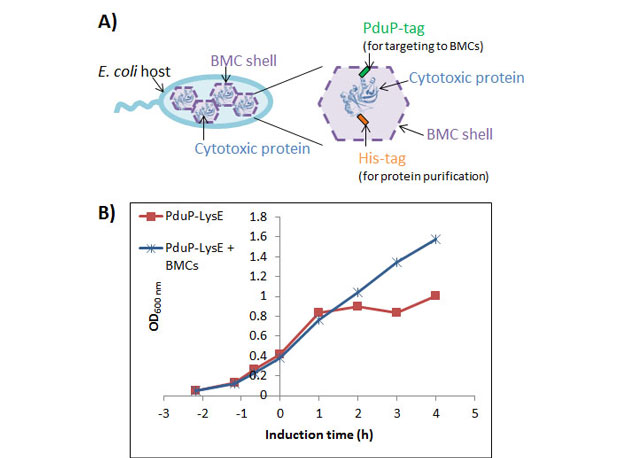Mimi Yung (15-LW-013)
Abstract
Over the past several years, synthetic biology has utilized the power of genetics to engineer microbes to produce novel products or functions, which has been enormously useful in the production of biofuels and bio-pharmaceuticals to address the world's energy, medical, and bio-defense needs. In addition, synthetic biology has potential applications in bioremediation via engineered microbes that can degrade toxic chemicals. The core of synthetic biology is the ability to engineer microbes to express novel biosynthetic enzymes or pathways in host cells, such as the Escherichia coli bacteria, that are able to rapidly reproduce and synthesize products of interest. We propose to develop bacterial cell-like "microcompartments" as novel platforms for synthetic biology. These microcompartments are bacterial organelles that are made of a protein shell that surrounds and encloses various enzymes. We will bioengineer the microcompartments to encapsulate heterologously expressed proteins in host cells to prevent cytotoxicity of the protein or reaction intermediates (see figure) and improve reaction efficiency, which are two major bottlenecks preventing the expression of novel proteins and functions in heterologous hosts. Heterologous expression refers to the synthesis of a gene or part of a gene in a host organism that does not naturally have this gene. As proof of concept, we will explore two applications: the expression of the cytotoxic antimicrobial protein CistronA in bacterial microcompartments for bio-pharmaceutical and bio-defense production, and the expression of the hydrocarbon oxidizer ToMO (toluene/o-xylene monooxygenase) in bacterial microcompartments for the bioremediation of trichloroethylene, commonly used as an industrial solvent.
We expect, if successful, to demonstrate that engineered bacterial microcompartments are able to alleviate host cell cytotoxicity of proteins or reaction intermediates, thereby enhancing non-native protein expression and improving reaction efficiency, which would be a major advancement in synthetic biology. We will develop a novel platform for synthetic biology based on the encapsulation of heterologously expressed proteins in bacterial microcompartments through the use of computational modeling; DNA cloning; protein expression, purification, and characterization; and transmission electron and fluorescence microscopy. We expect to demonstrate that this system has advantages compared to conventional protein expression systems because it can be used to express proteins that are normally cytotoxic to host cells, as well as improve reaction efficiency for enzymes that produce cytotoxic intermediates. This will have broad utility for the production of antimicrobial proteins, such as endolysin enzymes responsible for cleaving cell walls for viral reproduction, which have important bio-defense applications. The development of this platform will aid not only bio-pharmaceutical production of cytotoxic proteins relevant to bio-defense, but also biofuels production and bioremediation involving heterologous protein expression. The use of bacterial microcompartments could be applied in the future to complex bioremediation pathways, such as the degradation of polychlorinated biphenyl organic industrial pollutants.
Mission Relevance
If successful, bacterial microcompartments can be leveraged for the heterologous expression of many other proteins or biosynthetic pathways that are critical for antimicrobial drug development, biofuels production, and the cleanup of toxic chemicals in the environment. Additionally, the technology will have broad impacts in many fields of biology, which rely on the production of active protein for a diverse range of studies, including those in medicine and bio-defense, and supports the Laboratory's core competency in bioscience and bioengineering.
FY15 Accomplishments and Results
In FY15 we (1) constructed four over-expression systems (in which the shell proteins are over-expressed) for the production of empty bacterial microcompartments in E. coli and confirmed them to be functional; (2) prepared CistronA gene constructs with three different bacterial-targeting tags for the interior of the various empty microcompartment systems; (3) performed initial attempts to express CistronA using tunable expression, and as a backup plan, we targeted LysisE, another difficult-to-express cytotoxic protein, for the interior of our microcompartments using the established systems; (4) optimized toxic protein expression of at least one protein for bacterial microcompartments; and (5) prepared and tested the initial model to calculate the free energy associated with passage of a substrate through the shell protein pores of different bacterial microcompartments.
Publications and Presentations
- Yung, M. C., et al., Engineering bacterial microcompartments (BMCs) to shield toxicity during protein expression and purification. (2015). LLNL-POST-672368.






